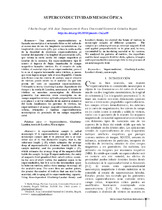| dc.contributor.author | Barba Ortega, José | |
| dc.contributor.author | Rincón Joya, Miryam | |
| dc.coverage.spatial | Seccional Bucaramanga | spa |
| dc.date.accessioned | 2021-02-08T21:19:21Z | |
| dc.date.available | 2021-02-08T21:19:21Z | |
| dc.date.issued | 2011 | |
| dc.identifier.uri | http://hdl.handle.net/20.500.11912/7995 | |
| dc.description | 5 p. | spa |
| dc.description.abstract | Una muestra superconductora es llamada mesoscópica si su tamaño físico es del orden de al menos una de sus dos longitudes características. La longitud de coherencia ξ(T), que estima la caída media de la densidad de electrones superconductores al interior del material y la longitud de penetración λ(T), que estima la caída media del campo magnético al interior de la muestra. En superconductores tipo II ocurre el ingreso de flujos cuantizados de campo magnético llamados vórtices. En el corazón de cada vórtice, el material deja de ser superconductor, pero sí lo es en el espacio intermedio entre vórtices, a menos que éstos logren ocupar toda el área disponible. Cuanto más firmes sean los centros de anclaje, mayor número de vórtices puede existir en el material sin que éste pierda del todo su capacidad superconductora. Utilizando la teoría Ginzburg-Landau dependiente del tiempo y la teoría de London, mostramos el estado de vórtices en muestras mesoscópicas de diferente geometría. Las muestras están sumergidas en un campo magnético externo aplicado perpendicularmente a su plano y a su vez rodeadas de un material aislante o del vacío. Analizamos los patrones de vórtices, las supercorriente y el campo magnético local para discos, esferas, triángulos y laminas superconductoras mesoscópicas en presencia de un campo magnético axial. | spa |
| dc.description.abstract | A superconductor sample is called mesoscopic if A superconductive sample is called a mesoscopic sample only if its physical size is at least either one of its two distinctive lengths, that is, the coherence length ξ (T), which estimates the average drop of superconductive electrons’ density inside the sample material, and the penetration length λ (T), which estimates the average drop of the magnetic field inside the sample. In type II superconductors, the entry of magnetic field quantized flow called vortices occurs. In the core of every vortex, the material ceases to be superconductive, but it is so in the intermediate space in between vortices, unless these manage to occupy all the available area. The more firm are anchor points, the greater the number of vortices that can exist in the material, still keeping all its superconducting capacity. Using time-dependent Ginzburg-Landau theory and London’s theory, we showed the Sstate of vortices in mesoscopic samples of different geometry. The samples are submerged into an external magnetic field and applied perpendicularly to its plan and, in turn, surrounded by an insulating material or by vacuum. We analyzed the patterns of vortices, the superflows and the local magnetic field for disks, spheres, triangles and superconductive mesoscopic foils in the presence of an axial magnetic field. | spa |
| dc.format.mimetype | application/pdf | |
| dc.language.iso | spa | |
| dc.publisher | UPB | spa |
| dc.relation.ispartof | Puente. Revista Científica | spa |
| dc.rights | Attribution-NonCommercial-NoDerivatives 4.0 International | * |
| dc.rights.uri | http://creativecommons.org/licenses/by-nc-nd/4.0/ | * |
| dc.subject | Superconductor | spa |
| dc.subject | Ginzburg- Landau | spa |
| dc.subject | teoría de London | spa |
| dc.subject | Mesoscópico | spa |
| dc.subject | London’s theory | spa |
| dc.subject | mesoscopic | spa |
| dc.title | Superconductividad mesoscópica | spa |
| dc.type | article | spa |
| dc.rights.accessRights | openAccess | spa |
| dc.type.hasVersion | publishedVersion | spa |
| dc.description.sectional | Bucaramanga | spa |
| dc.identifier.instname | instname:Universidad Pontificia Bolivariana | spa |
| dc.identifier.reponame | reponame:Repositorio Institucional de la Universidad Pontificia Bolivariana | spa |
| dc.identifier.repourl | repourl:https://repository.unab.edu.co/ | |


